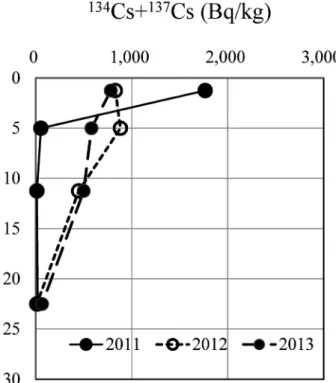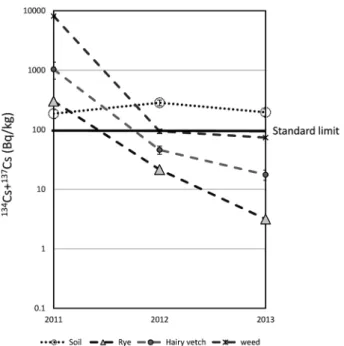Radi oc es i um
Cont am
i nat i on of Cover Cr ops and
Soybeans i n I bar aki af t er t he Fukus hi m
a
D
ai i c hi N
uc l ear Pow
er Pl ant Ac c i dent
著者
H
O
SH
I N
O
Yut a
j our nal or
publ i c at i on t i t l e
J our nal of D
evel opm
ent s i n Sus t ai nabl e
Agr i c ul t ur e
vol um
e
12
num
ber
1
page r ange
13- 16
year
2017- 05- 26
U
RL
ht t p: / / hdl . handl e. net / 2241/ 00150268
Radiocesium Contamination of Cover Crops and Soybeans in
Ibaraki after the Fukushima Daiichi Nuclear Power Plant Accident
Yuta Hoshino*
Ibaraki University, Chuo 3-21-1, Ami-machi, Ibaraki 300-0393, Japan
This paper discusses the radioactive contamination of soybean fields in Ibaraki from 2011 to 2013 after the 2011 accident at the Fukushima Daiichi nuclear power plant (FDNPP). After the accident, large quantities of radioactive material were released, some of which was deposited on the ground. However, although agricultural produce from this region has levels of radiocesium below the maximum permitted concentration in food, people refrain from buying agricultural produce from this region, and negative information still persisted in 2015. In this study, as part of efforts to further reduce levels of radiocesium and restore consumer confidence in agricultural products from Ibaraki prefecture, we examined the effects of different tillage systems (moldboard plow, rotary cultivation, and no tillage) and three types of winter cover crop (fallow weeds, rye, and hairy vetch). Measurements taken before tillage in 2011 showed that the radiocesium concentration in the surface soil (0-2.5 cm) was higher than that in deeper layers (2.5-15
cm). However, after rotary cultivation in 2012, the concentration in the 0-2.5 cm layer was reduced and that in the 2.5-15 cm layer was increased. The concentration in weeds was significantly higher than those in the hairy vetch or
rye during 2011 to 2013. The transfer factor (TF) in weeds was higher than that in hairy vetch or rye from 2011 to 2013. The radiocesium concentration and TF in soybean crop residue were higher than harvested soybeans those in from 2011 to 2013, although those in the soybeans were lower than the limits in food determined by the Ministry of Health, Labor and Welfare of Japan. The radiocesium contamination of soil, soybeans, and cover crops has decreased every year since the FDNPP accident. To further reduce the uptake of radiocesium into crops and restore market confidence in agricultural produce from Ibaraki, it is necessary to conduct more studies on the relationship between radiocesium and soil and crops.
Key words: cover crop, FDNPP accident, radiocesium, soybean, transfer factor
───────────────────────
Introduction
Following the Great East Japan earthquake of 11 March 2011, a huge tsunami struck the Tohoku district, seriously damaging the Fukushima Daiichi Nuclear Power Plant (FDNPP). A large quantity of radioactive material was released, including 134Cs (half-life of 2.06 years) and 137Cs (half-life of 30.2 years), which have harmed local agriculture.
Research by the Ibaraki Prefectural Government (2015) suggests that people are still reluctant to buy agricultural produce from Ibaraki prefecture. In March and April 2011, high levels of radioiodine from the
FDNPP accident were detected in agricultural produce from Ibaraki, and several lines of agricultural produce were withdrawn from the market because of radio-active contamination. Because of longevity of half-life radioiodine is a week this contamination were disappear after one month later, however, radiocesium concentrations in produce have been far below the provisional standard limits in food (500 Bq/kg). Im-mediately after the FDNPP accident, the price of vegetables in the Metropolitan Central Wholesale Market which located at Tokyo fell dramatically and was less than in the same month the previous year. Around June 2011, the market price had recovered to
Received: February 29, 2016, Accepted: April 5, 2016
90% of that of an average year, and in January 2012, it was over 100%. Over the whole of 2012, the price of vegetables in the Metropolitan Central Wholesale Market was 93% of that in an average year. However, despite the recovery of market prices of vegetables from Ibaraki, sales of vegetables for commercial pro-cessing and numbers of customers at fruit farms and farmers’ markets began to decrease (Yomiuri Shimbun,
2015).
Today, radioactive contamination of agricultural produce is far below the new standard limit (100 Bq/kg). Thus, demand for agricultural products from Ibaraki prefecture should be experiencing a recovery. However, a survey conducted by theYomiuri Shimbun
(2015) 4 years after the accident shows that although the number of customers in the Tokyo area who choose not to buy produce from Ibaraki has decreased to below 10%, people from the Kansai and Hokkaido areas are still reluctant to buy agricultural produce from Ibaraki. This result shows that negative percep-tion still strongly persists.
Radiocesium contamination in soil has been dis-cussed by many researchers. For example, after the FDNPP accident, Harada and Nonaka (2012) found higher concentrations of radioactivity in a rice field in Niigata in shallower soils in general; Katoet al. (2012) reported the depth distribution of radionuclides in Fukushima; and Shiozawa et al. (2011) reported the vertical distribution of radiocesium concentration in a rice field at Fukushima. However, there are few studies of the transfer of radiocesium from soils to crops in Ibaraki.
Therefore, as part of our efforts to restore consumer confidence in agricultural products from Ibaraki prefecture, we are studying ways to reduce the uptake of radiocesium into crops. Recently, we reported that tillage can reduce uptake (Hoshinoet al., 2015). Here, we investigated the annual trends of radiocesium concentration and transfer factors (TFs), which relate soil concentrations to plant concentrations of con-taminants (Kostiainenet al., 2002), in cover crops and soybeans.
Experimental site
This experiment was conducted at the Ibaraki University Center for Field Science Research & Edu-cation study site in Ami, Ibaraki prefecture (soil texture: CL LiC Andisol), from 2011. The site is ap-proximately 170 km southwest of the FDNPP. The
main summer crop is soybeans (cv. Natto-shoryu). Cover crops of hairy vetch (Vicia villosaRoth), winter rye (Secale cereale), or natural fallow weeds ar0e used as green manure in winter. Tillage type and cover crop were the experimental factors. Tillage systems were rotary cultivation (15 cm deep).
Radiocesium contamination in soil
In 2011, the concentration of radiocesium in the surface layer (0-2.5 cm) before tillage was 1766.3 Bq/kg, far higher than the 20.5-53.6 Bq/kg found in the lower layers (2.5-30 cm) (Fig. 1). In 2012, after rotary cultivation, the radiocesium concentration in the 0-2.5 cm layer was 829.7 Bq/kg, lower than in 2011, and that in the 2.5-15 cm layer was 447.6-883.2 Bq/ kg, higher than in 2011. It was 11.1-66.5 Bq/kg in the deepest soil layer (15-30 cm). Rotary cultivation can till to a depth of only 15 cm, and the radiocesium con-centration tended to be uniform (Fig. 1).
Radiocesium contamination in cover crops
Cover crop species were winter rye, hairy vetch, or native weeds (fallow). Every year, rye accumulated the most biomass, and the weeds accumulated the least.
J. Dev. Sus. Agr. 12 (1)
14
Fig. 1. Vertical distribution of radiocesium (134Cs
The radiocesium concentrations were 73.7-8134.6 Bq/ kg in weeds, significantly (p<0.05) higher than the 17.5-1035.2 Bq/kg in hairy vetch and the 3.1-186.1 Bq/kg in rye, from 2011 to 2013 (Fig. 2). TFs were 0.35-50.32 for weeds, 0.08-6.41 for hairy vetch, and 0.01-1.87 for rye, from 2011 to 2013 (Fig. 3).
The radiocesium concentrations in the cover crops were significantly (p<0.001) reduced during the three years from 2011 to 2013 (Figs. 2, 3).
Radiocesium contamination in soybeans
The radiocesium concentrations were 6.5-12.7 Bq/
kg in soybean grain, lower than the 9.7-36.5 Bq/kg in soybean crop residue, from 2011 to 2013 (Fig. 4). TF values of the grain were 0.03-0.08, which were also lower than the 0.05-0.23 of the crop residue (Fig. 3). After the FDNPP accident, the concentrations in both grain and crop residue were lower than the limit in food (Ministry of Health, Labor and Welfare 2012) (Fig. 4). The concentration in soybeans in 2012 was dramatically less than that in 2011.
Conclusions
The vertical profile of radiocesium after rotary cultivation was completely different from that before tillage. Furthermore, radiocesium concentrations were higher in the surface soil than in the deeper soil layers. Levels of soil and crop contamination by radio-cesium and the TF values have decreased after the FDNPP accident. This decrease is explained by the short 2.06-year half-life of 134Cs, soil erosion by till-age, and radiocesium uptake by crops.
However, although the levels of radiocesium are below the official maximum permitted levels, the soil and crops are still highly contaminated by the long-lived radionuclide137Cs (half-life of 30.2 years). There-fore, further studies are needed in order to fully reveal the relationships between radiocesium and soil and crops.
Fig. 2. Radiocesium concentrations (134Cs+137Cs) in cover crops (2011-2013). Modified from Hoshinoet al. (2015).
Fig. 3. Transfer factors in cover crops and in soy-bean grain and crop residues (2011-2013).
To solve the problems of residual contamination and the reluctance of consumers to buy agricultural pro-ducts from Ibaraki prefecture, If these problems define problems here are to be solved local residents need to understand the situation with respect to food safety and conduct appropriate countermeasures when growing crops in Ibaraki prefecture. Moreover, the meaning of “local food” needs to be reconsidered, and restoring the confidence of the consumers beyond local markets is necessary.
Acknowledgments
I thank Dr. Masakazu Komatsuzaki (College of Agriculture, Ibaraki University) for his constructive comments and warm encouragement. This study was supported in part by a grant from the School of Agri-culture, Ibaraki University.
References
Harada, N., Nonaka, M., 2012. Soil radiocesium distribution in rice fields disturbed by farming process after the Fuku-shima Dai-ichi Nuclear Power Plant accident. Sci. Total
Environ. 438, 242-247.
Hoshino, Y., Higashi, T., Ito, T., Komatsuzaki, M., 2015. Till-age can reduce the radiocesium contamination of soybean after the Fukushima Dai-ichi nuclear power plant accident. Soil Till. Res. 153, 76-85.
Ibaraki Prefectural Government, 2015. http://www.pref.ibaraki. jp/nourinsuisan/hanryu/hanbai/page/documents/report2014. pdf (in Japanese) (accessed February 23, 2016).
Kato, H., Onda, Y., Teramage, M., 2012. Depth distribution of 137 Cs, 134 Cs, and 131 I in soil profile after Fukushima Dai-ichi Nuclear Power Plant accident. J. Environ. Radio-act. 111, 59-64.
Kostiainen, E., Haenninen, R., Rosen, K., Haak, E., Eriksson, Å., Nielsen, S.P., Keith-Roach, M., Salbu, B., 2002. Trans-fer factors for nuclear emergency preparedness. http:// www. iaea. org/inis/collection/NCLCollectionStore/_Public/ 34/025/34025739.pdf (accessed February 23, 2016). Ministry of Health, Labour and Welfare, Japan, 2012. http://
www.mhlw.go.jp/english/topics/2011eq/dl/new_standard. pdf (accessed February 23, 2016).
Shiozawa, S., Tanoi, K., Nemoto, K., Yoshida, S., Nishida, K., Hashimoto, K., Sakurai, K., Nakanishi, T., Nihei, N., Ono, Y., 2011. Vertical concentration profiles of radioactive ce-sium and convective velocity in soil in a paddy field in Fukushima. Radioisotopes. 60, 323-328.
Yomiuri Shimbun, 2015. (in Japanese) April 9, 2015 J. Dev. Sus. Agr. 12 (1)

